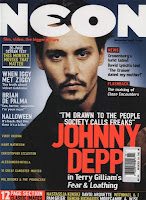Having analysed posters for conventions, the next thing to do would be to look at posters in terms of genre, but as I haven't yet decided what genre I want to do I am going to look at magazine publications.
Below are a list of
20 existing film publications, with brief analysis of content, style and audience. This research will help me when I come to design my own magazine front cover and has helped me think about the most appropriate type of magazine that would promote my film.
My research has shown that there are many different kinds of film publications, catering to a wide range of different audiences. All of the magazines are used to help promote forthcoming films, though the types of films being promoted often change depending on the type of magazine.
Some magazines largely promote mainstream Hollywood films (Total Film, Empire) whilst other magazines promote independent or British films (Sight and Sound).
Some magazines focus almost exclusively on older, cult films (Neon, Cinema Retro), some are aimed at fans of particular genres (Starburst, Shivers, Mad Monster), whilst others focus on specific areas of the film industry (American Cinematographer).
The type of magazine I choose to help market my film, will depend on the following: audience, the genre of my film and whether my film is independent or mainstream.
1. Cinema Retro: Cinema Retro is a British magazine focusing on "celebrating films of the 1960s and 1970s". Founded in 2005 by Lee Pfeiffer and Dave Worrall, it is subtitled "the essential guide to cult and classic movies." The 64 page full colour magazine is published three times a year with a wide range of rare or previously unseen press photographs. The focus of this magazine is not on current movies and it is therefore unlikely recent releases will be promoted.
2. Little White Lies: Little White Lies is a bi-monthly, British independent magazine that features writing, illustration and photography related to cinema, Little White Lies' content is split into six sections: the lead review, an editorial introduction, a series of articles inspired by the feature film, theatrical reviews, the back section and future releases.
3. Total Film: Total Film is a British film magazine published 13 times a year. The magazine was launched in 1997 and offers film, DVD and Blue-ray news, reviews and features. It is the second biggest selling film magazine in Britain after Empire, and predominantly features Hollywood movies. The cover image is often of a globally recognsable a-list star.
4. Empire: Empire is a British film magazine published monthly. It is the biggest selling film magazine in Britain and is also published in America, Australia, Turkey, Russia and Portugal. Empire organises the annual Empire Awards which are voted for by the readers of the magazine. Focuses mainly on mainstream Hollywood blockbusters and the cover often features images of Hollywood stars or recognisable characters from franchise movies.
5. Sight and Sound: This magazine reviews all film releases each month, including those with a limited (arthouse) release, as opposed to most film magazines which concentrate on those films with a genreal release. Sight and Sound features a full cast and crew credit list for each reviewed film. Sight and Sound has a niche audience, and focuses on smaller, independent and British films. Often the image on the front cover is of a director; if the cover features a well-known star it will be because they have appeared in an arthouse film.
6. Starburst: Starburst is a British science fiction magazine. The magazine is published monthly with additional news and reviews being published daily on the website. Starburst contains news, interviews, features and reviews of genre material in various media, including film. Used to promote forthcoming releases of films and TV shows within the genre.
7. Screen International: Screen International is a multimedia film magazine focusing on international cinema. The magazine is published weekly. The company also produces daily publications at film festivals. The magazine is aimed at people who work within the industry rather than average film fans and therefore includes box-office statistics and features with crew rather than actors.
8. Film Review: Film Review started out as a promotional magazine for the ABC circuit. It became a popular monthly magazine featuring news and information, literate reviews and pictorials. For nearly sixty years it was one of the most appealing publications for film fanatics and covered a wide range of genres and styles of films.
9. American Cinematographer: American Cinematographer focuses on the art and craft of cinematography and features in-depth interviews with cinematographers, directors and some of their collaborators. This niche magazine also features historical articles and information on the technology that impact the craft.
10. Neon: Neon was a refreshing alternative to other UK film magazines such as Empire as whilst it included latest film news, previews, actor profiles, interviews and contemporary movie profiles (all written with a sense of humour), it also featured discussion of classic and cult films.
11. Hotdog: Hotdog tended towards a cynical view of the industry, especially Hollywood. It avoided the blockbuster bandwagon and published pieces which appeared to be contrary to widespread opinion. However in its last few years the magazine moved towards the mainstream film press.
12. Shivers: Shivers magazine was a British film magazine focusing mainly on the horror genre (not just films, but also television programmes and literature). The magazine cover often featured contemporary horror films, but would also make reference to cult films from the genre.
13. Bright Lights Film Journal: This is an online academic film magazine, with a left-learning critical orientation
14. Cineaste: Cineaste is a film magazine which is published quarterly. It features reviews, in-depth analyses and interviews. The magazine independently operates in New York without any financial ties and covers mainly films outside of the mainstream.
15. Premiere: Premiere was an American mainstream film magazine. The magazine was released ten times a year and included regular features like letters from readers, a spotlight on "hot" screenwriters and behind the scenes articles.
16. MovieMaker: MovieMaker is an American film magazine focused on the art and business of making movies, with an emphasis on independent film. Featured articles include moviemaking techniques, trends, technology and product updates. The cover often features an image of a director or a star from outside of the mainstream.
17. Cinefex: Cinefex is a quarterly special effects magazine, aimed at a niche audience. It is one of the first special effects magazine ever published and the features include lengthy and detailed articles about the special effects of upcoming films.
18. Femme Fatales: This magazine is a mens magazine focusing on film and television actresses. It focused on science fiction, fantasy and horror actresses, featuring provocative pictorials alongside extensive career interviews. Interviews with film makers helped to boost the "Scream Queen" market.
19. Scarlett Street: Scarlet Street was an American film magazine that specialised in the genres of horror, mystery and film noir. Its initial concentration was on Sherlock Holmes, however later its subject matter expanded to include a variety of other genres.
20. Mad Monster: Mad Monster is a US based horror magazine, featuring games, puzzles, paper models and even flip-books.























Excellent, thorough analysis of a wide range of film magazines, showing a very good understanding of audience and genre.
ReplyDeleteI look forward to seeing which type of publication you use to promote your film.
Good work.
AJM